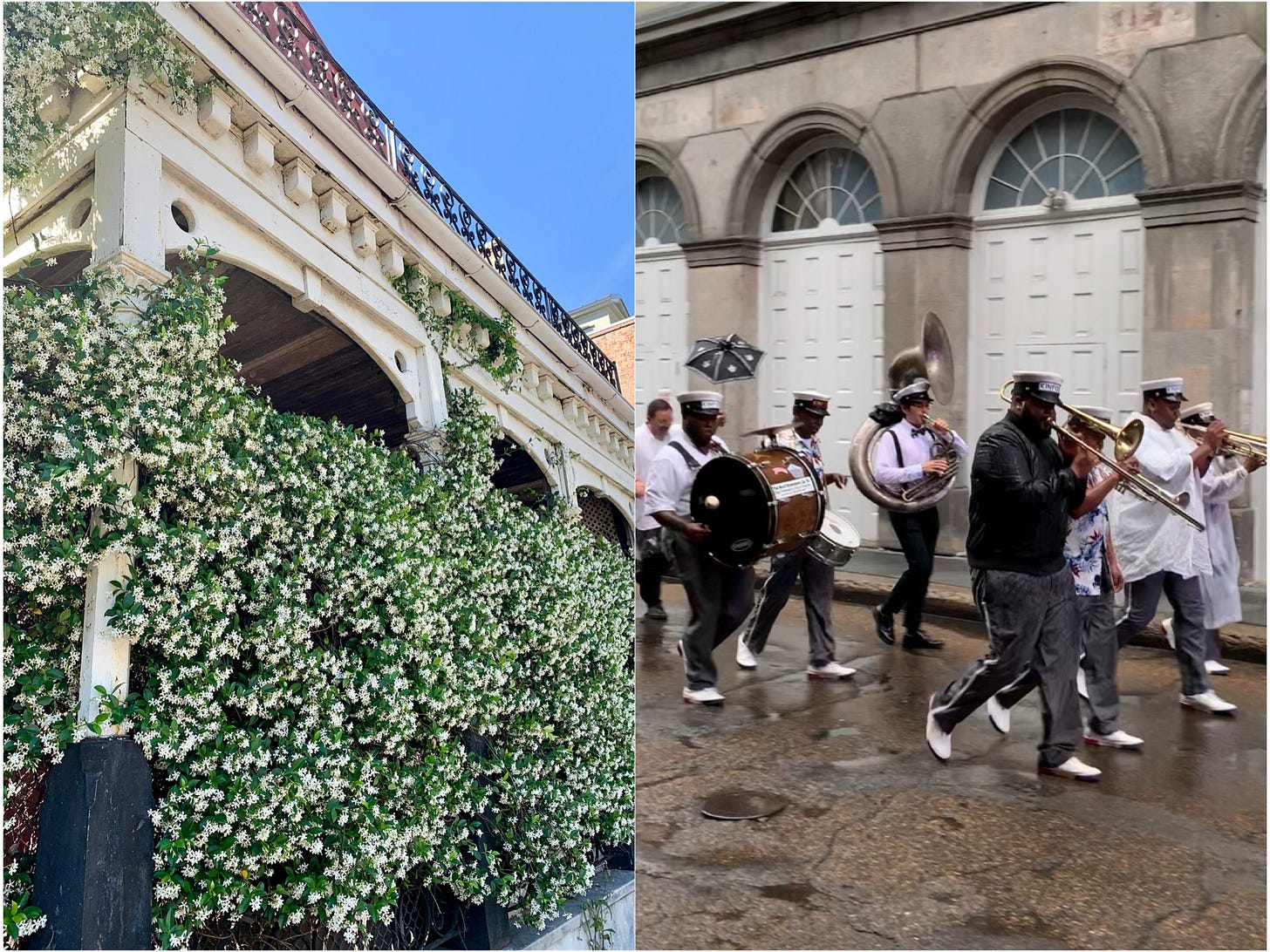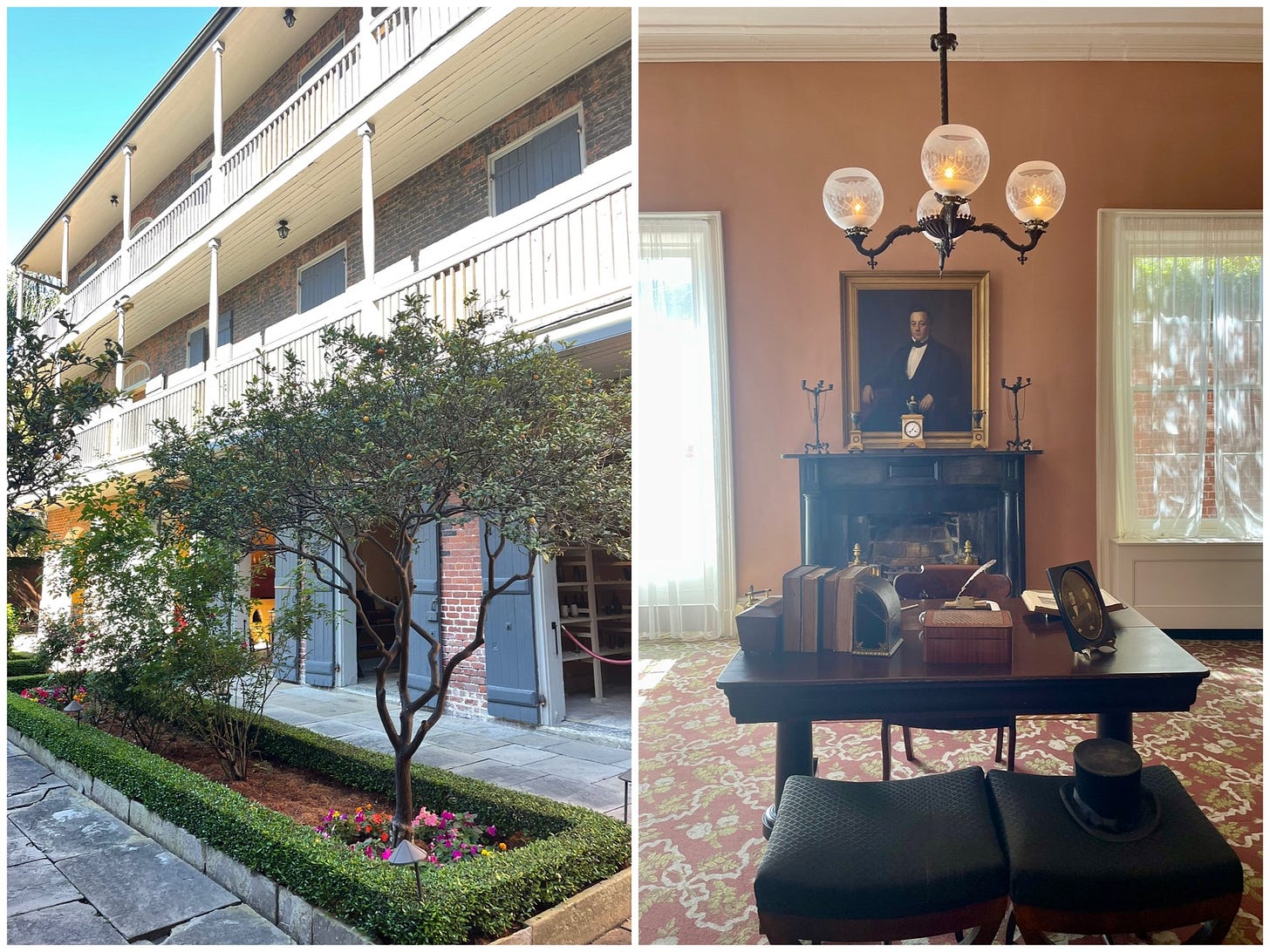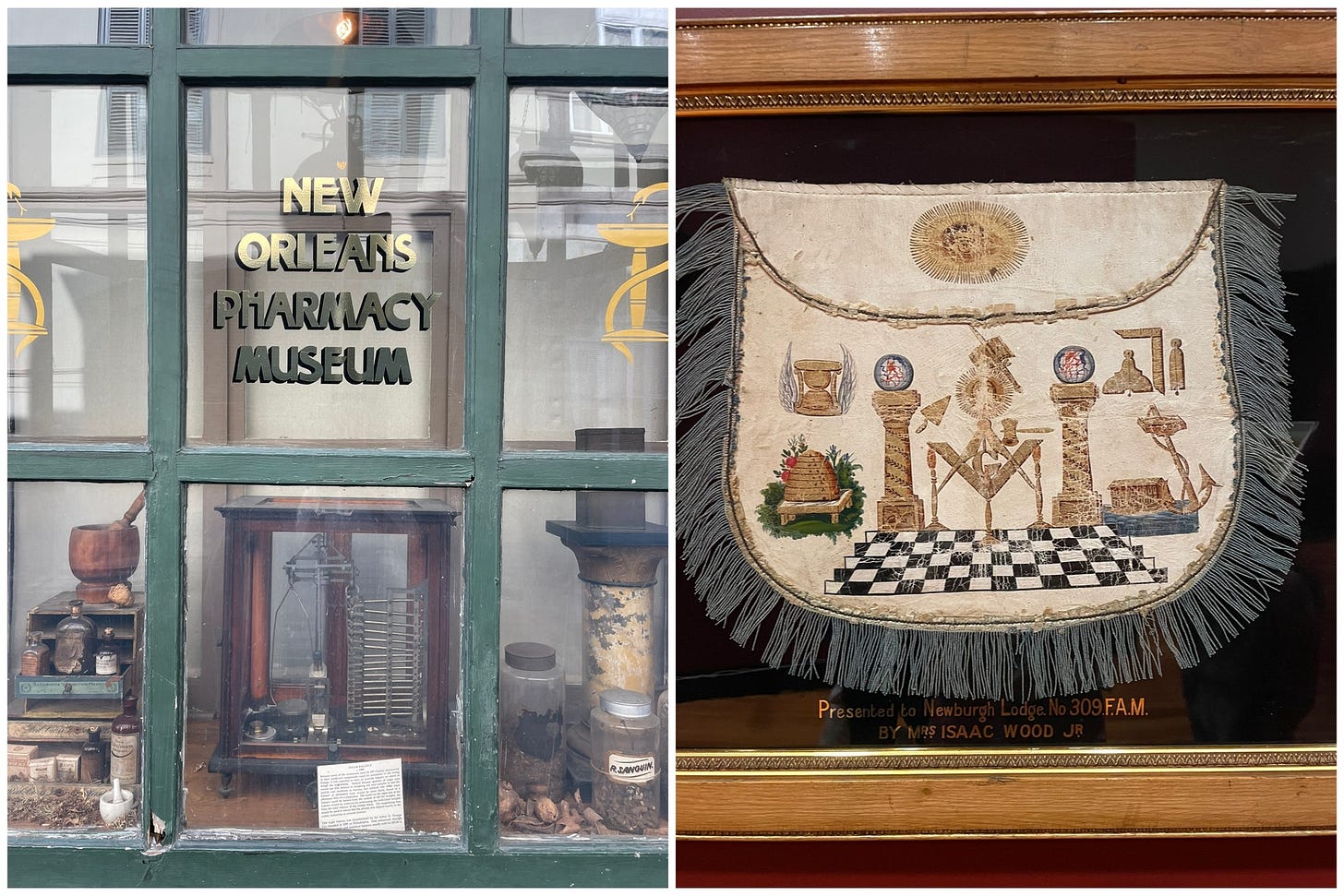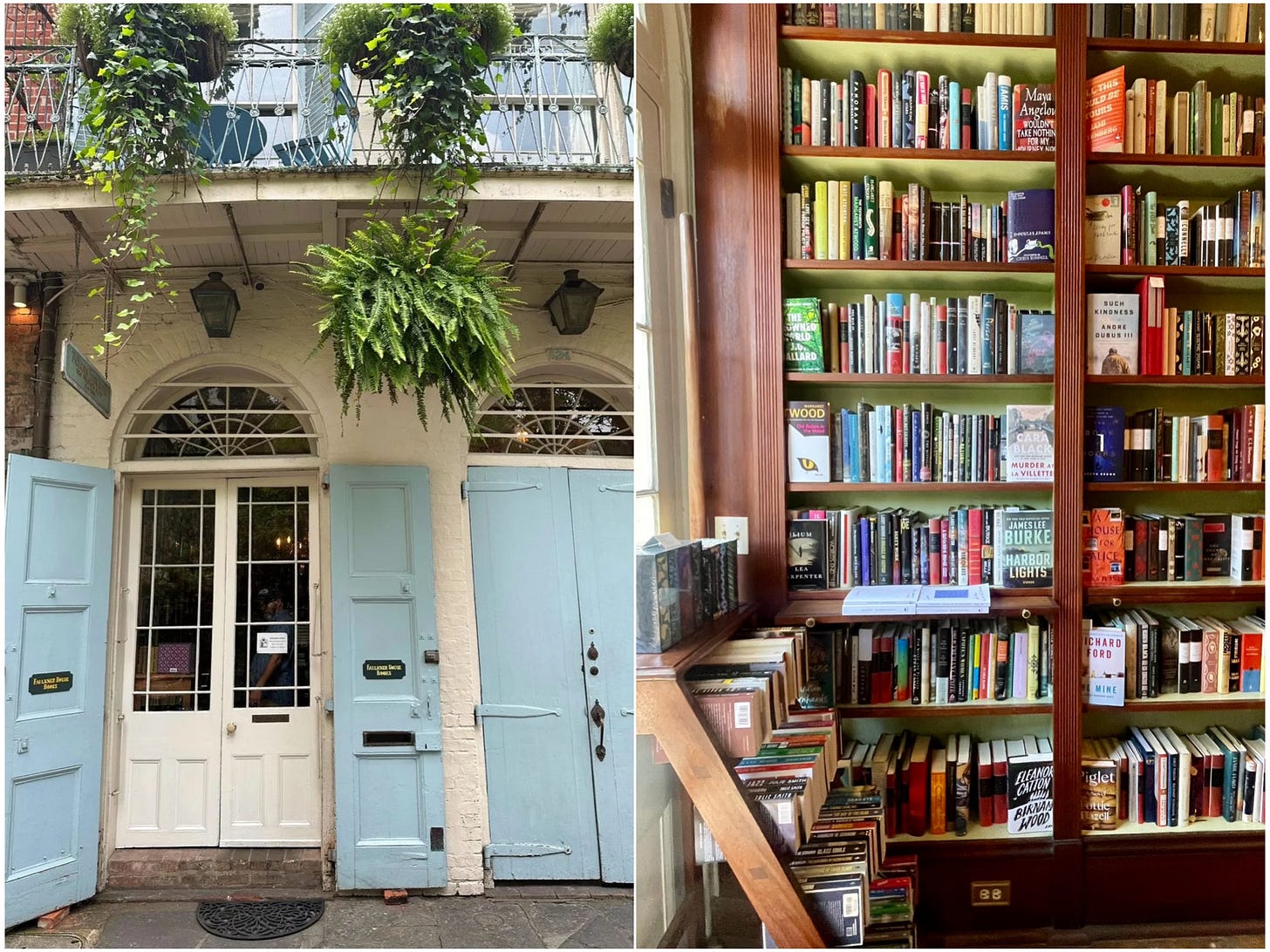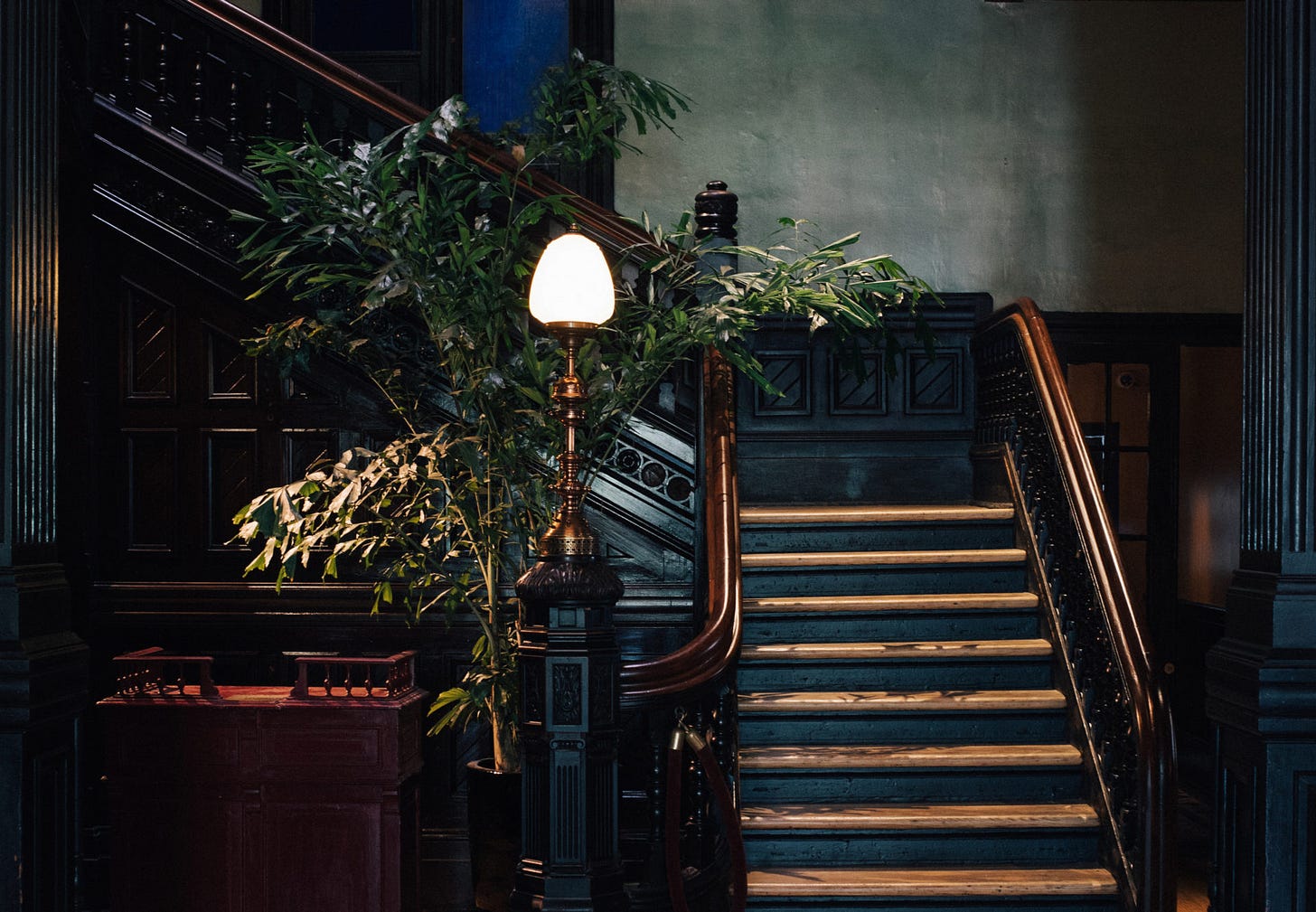Dispatch from the Past: Old New Orleans
A guide to the faded grandeur—in the best possible way—of the city’s tried and true
I love the way New Orleans feels, especially in the spring—the sun is shining, confederate jasmine blankets facades and spills from balconies. You need only to open your eyes to appreciate the beauty of this exuberant, well preserved city. The elaborate cast-iron balconies of the French Quarter, the double-height Italianate porches of the Garden District’s mansions. Intricately detailed medallions, lintels, lamplights, fleur-de-lis, door knockers, tall shutters, French doors and double-hung windows. The brightly colored Creole cottages of the Bywater and Marigny are turquoise and purple, lime green and cherry red with marigold yellow accents. Walking down the street is a kaleidoscopic experience, every street a shift of the crank.
Of course, there are plenty of new restaurants/shops/galleries/hotels, but I’m here for the tried and true, the faded grandeur of it all—the peeling paint, the moody low-lighting, the moldering beauty. Here, a list of classic timeworn haunts where the spirit of old New Orleans feels as alive as ever. While certainly no secret to tourists, I love that these beloved institutions are just as cherished by locals. You can’t plan New Orleans the way you might other places. In a city this eccentric and spirited, your time should be led by whim and curiosity. There will always be something unexpected to distract and delight: A second line booming down the street or something a street musicIan who’s as talented as the guy at Preservation Hall last night. Put your loose framework in place, and let the mystery and serendipity work its magic.
THE FADED GRANDEUR OF OLD NEW ORLEANS
Hermann-Grima House // This elegant, well-preserved Creole home sets the stage for everything you’ll see in New Orleans, reminding you of the labor required to create and maintain such grandeur. A few years ago, the tour of was shifted to better reflect the experience of the enslaved, rather than simply showcasing the gorgeous rooms dripping with gilded mirrors, marble-topped chests, and damask drapes. It’s a deeply moving experience that brings the complexities of 19th-century life into sharp focus.
I’ve also toured and really enjoyed the the Pitot House, an 18th-century Creole colonial country home in Bayou Saint John neighborhood.
Historic New Orleans Collection // Quiet and spare, this free museum is reprieve from the madness of the French Quarter. Duck inside for regularly rotating exhibitions, like last spring’s excellent Mystery and Benevolence exhibition, dedicated to Masonic and Odd Fellows folk art and handmade objects, as well as the symbology and lore of these two secret societies. If it’s a rainy day, extend your exploration with the reading room around the corner, where the eager archivists can help you find strange delights, like a list of old New Orleans superstitions.
The Pharmacy Museum // A fascinating look into the early pharmaceutical past, this tiny eccentric museum is a time capsule full of pharmacists’ recipe books, vintage bottles, ephemera, medical objects and instruments, a big porcelain pot labeled “leaches,” and an 1855 Lippincott soda fountain. Gorgeous carved-wood cabinets showcase exotic (terrifying?) tonics, elixirs, ointments, cordials, powders, and purgatives that will make you feel all the more grateful for our sterile modern doctor’s offices— however soulless the interiors may feel in comparison.
Backstreet Cultural Museum // A little corner Creole cottage that houses the largest collection of Mardi Gras Indian suits in the city. The ultimate local craft, these brilliantly colored, elaborately designed, handmade suits take up to a year to make and glow with thousands of beads, shells, rhinestones, sequins and feathers. I really can’t overstate the cultural significance of this place. The suits are complemented by parade footage and homespun placards about the tribes and their suits, and whether or not you’ve seen these magnificent costumes in action, it’s impossible not to experience the pure joy they carry. You can read about the history of the museum and its founder, creative director and cameraman Sylvester Francis.
Faulkner House Bookstore // Just off busy Jackson Square, this jewel box of a bookshop is truly “a sanctuary for fine literature.” The backstory, straight from the Faulkner Society: William Faulkner lived on the ground floor in 1925, and sub-leased the ground floor from William Spratling, the famous artist, jewelry designer, and architect, who leased the whole house from a Creole family. While living on Pirate’s Alley, Faulkner and Spratling produced a book satirizing their friends, Sherwood Anderson and Other Famous Creoles. He also ate here, drank here, partied here, fell in love on the balcony here, wrote letters from here, gathered inspiration here and, most importantly, became a novelist here.
Garden District architecture tour with a stop at Columns // My favorite thing to do in New Orleans is to bike through the Garden District, looking at the grand old dames and making two important stops: the Lafayette Cemetery No. 1 followed by a drink on the epic Italianate porch at Columns. Sometimes we ride all the way to Audubon Park to visit the Tree of Life (the Étienne de Boré Oak)—a large, historic southern live oak planted around 1740. My kids love to climb its sprawling, low-hanging branches.
Antique shops // I can lose an entire day to the antique shops on Magazine Street, an endless parade of over-the-top things I can’t afford or carry home: French cast-iron daybeds and Art Nouveau armoires; opulent chandeliers and bronze sculptural sconces; Tiffany lamps; elegant longcase clocks; majolica, porcelain, and 18th century silver; marble mantels and gilt mirrors.
RESTAURANTS
Napoleon House // Built as an intended refuge for the exiled ex-Emperor of France as part of a bizarre plot that never came to fruition, it’s possibly the most atmospheric restaurant of all time, as patina-ed as they come, with a reputation for authentic traditional fare that manages to supersede its history. Muffalata, jambalaya, gumbo and Pimm’s Cup.
Commander’s Palace // The stuff of epicurean legend, dating back to 1880. Still serves up refined Creole fare and an elegant jazz brunch in its chandelier-strewn dining room (don’t miss cheeky little characters with hand-embroidered hair in the toile wallpaper). It’s the robin’s-egg blue exterior, striped awnings and iconic light-up sign that gets me.
Casamento’s // More than 100 years old, and started by the current owner’s grandfather. Fresh oysters and seafood gumbo, plus its original signature interior tile , which, so the story goes, had to be sourced from four different tile companies across the country to fill the order back in 1919.
Antoine's Restaurant // A decadent (with prices to match) 177-year-old French Quarter staple with the distinction of being the oldest family restaurant in America AND the oldest restaurant in New Orleans AND the birthplace of Oysters Rockefeller. After dinner—elevated French-Creole—guests are offered a tour of the never-ending labyrinth of grand dining rooms. All 14 of them decorated differently, full of history and stories, including one that famously holds more than 100 years of gifts and memorabilia, including a collection of demitasse cups.
Cafe du Monde // There are going to be tourists—lots of them—and a line. Don’t fret too much, it’s an institution (circa 1862) for many reasons, including a sprawling outdoor patio with green striped awning, the best beignets, and your choice of chicory coffee, fresh squeezed orange juice or hot chocolate.
There are so many more old gems, from Galatoire’s at the tuxedoed end of the spectrum to legendary Dooky Chase’s for Creole classics in an historic family-owned Treme building they originally opened as a sandwich shop and lottery ticket outlet.
HOTELS
Hotel Peter and Paul // Favorite hotel in New Orleans (which, in a city of over-the-top hotels, is really saying something), this beautifully renovated church/schoolhouse/convent/ rectory in the Marigny is pure theatrical whimsy—gingham drapes, lavish canopies, lush colors, graceful European antiques and an endless cascade of silk tassels. It’s not only that the interiors are dripping with jewel-toned fabrics and circus-worthy feats of drama, it’s that, somehow, incredulously, it all feels so down-to-earth and unfussy. Opened 2018, but feels like it’s been here 100 years; the rectory, in fact, dates back to 1875.
The Soniat House // I’ve stayed here in the past and loved it. Old school, beautiful courtyard, canopied beds and creaking floorboards. On the edges of the French Quarter, far enough away from the hubbub to feel like a quiet residential respite.
Hotel Saint Vincent // An old 1883 infant asylum, which doesn’t feel particularly warm-fuzzy, gets the Liz Lambert design treatment with all the modern trappings, including a dreamy palm-strewn courtyard with pool. Not feeling convinced? Me neither, but everyone I know who has stayed here seems to love it.
Columns // A grand ole manse hotel in the Garden District with simple, renovated rooms (wallpaper, antiques, soaking tubs) atop the first-floor restaurant and renowned front porch and courtyard.
LIGHTNING ROUND FROM A LOCAL
Nathalie Jordi, co-founder of Hotel Peter and Paul and also, formerly, the editor of Wildsam’s New Orleans guide, knows a thing or two about this city. This is the list she gave me last time I was in town with my daughter.
Killer Po Boy: Inside the Erin Rose tavern is a hidden po-boy shop — go for the shrimp.
Neighborhood vibe: Music Box Village
Sno balls: Hanson’s
Liuzza's by the Track: great gumbo, bookies, by the racetrack
Hidden delight: Walk into Arnaud’s French 75 bar. Don’t eat anything (food sucks) or drink anything (because you’re with a 10 year old—otherwise the bar is amazing), but go upstairs to the hidden Germaine Wells Mardi Gras museum. Creepy and secret but there if you know about it.
For visual appreciation: Le Croissant D'Or—pastry shop in FQ with great tile and bad pastries.
Only in New Orleans: Angelo Brocato’s, a Creole-Italian ice cream shop
Fun shops in FQ: Fifi Mahoney's (outlandish Mardi Gras wig shop); Papier Plume for wonderful notebooks and fountain pens; and the Bevolo gas lantern shop
Unexpected opulence: New Orleans Athletic Club—private gym in an old men’s club, you can buy a day pass, play racquetball or go swimming in a small, cold pool
Tourist activity you shouldn’t miss: Preservation Hall—one of the rare places you can see music with someone under 21. It’s 100 percent tourists, but nevertheless still pretty cool—both the building and the music. Shows start at 5 pm.
Extra credit: you can take the five-minute ferry across to Algiers Point, you can have lovely coffee at Congregation Coffee & tacos at Barracuda and explore Algiers Point, a neighborhood that feels a lot like the Marigny, but on the other side of the river. Little-known.
Nature outing: In City Park, on the big lake where the swan boats are, you can rent a kayak (kids under 10 need to go in a double kayak with you, kids above 10 can have their own). I recently did this for the first time after living in Nola for 15 years and couldn’t believe I hadn’t done it sooner. You can go into all the waterways in City Park — through the sculpture garden, back behind Cafe du Monde (where you should stop for beignets, either during your kayak ride or after), and into nether regions it feels quite wild, relatively speaking. A really surprising and beautiful view on a park I thought I had visited all the angles of. Also wonderful in City Park: the botanical gardens (primo at this time of year), the sculpture garden, and the chime tree.




